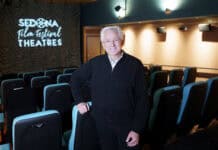About half of the 40 applicants who responded to a 2015 Request for Proposals for hiking-based guided tours put out by the Red Rock Ranger District were turned down.
The high number of rejections for this category of permits left some Sedona lovers and residents with a bitter taste that still lingers today.
Flagstaff photographer Jody Tanner counts herself among those. Tanner, who also works as a speech pathologist, says that she started conducting photography tours in Northern Arizona after hiring a photography guide in Telluride, Colo., and coming home with great shots.
When the RFP for “hiking-based outfitting and guiding” was issued in 2015, she worked for two weeks on a joint proposal with her son, who lives in the Verde Valley, to guide photographers to iconic sights in red rock country.
“I’ve lived in Arizona since 1976 and have hiked all over,” Tanner said. “We put in a proposal to take small groups of three people out into the Red Rock [Ranger] District to very common places for photography — the scenic locations so people can come home with great photos.”
At the time, Tanner was thinking about retiring and said she would have tried to guide on a part-time basis if granted a permit.
But when the U.S. Forest Service sent applicants a letter later that year with the names of the successful outfitters, Tanner and her son were not on the list.
“My son and I came away with a really bad feeling,” Tanner said. “I don’t think they should have severely limited the number of permits.”
Tanner, who said she has experience writing grant applications, blamed the failure on two factors: Not being a local and not being a large revenue generator.
But Julie Rowe, Recreation Special Uses Program manager for Coconino National Forest, of which the Red Rock Ranger District is one of three units, disputed the idea that revenue potential and local favortism are factors in awarding permits for the Red Rock Ranger District’s outfitter and guide programs.
She pointed out that the applications for the hiking-based tours were evaluated by a panel of USFS recreation specialists brought in from outside of the Coconino National Forest. The three-person panel evaluated the proposals based on five criteria, which were outlined in a detailed prospectus given to applicants. The Forest Service created a separate permit program for metaphysical and spiritual hiking tours, so the focus of the hiking tours in the RFP in question was visitor education. In order of importance, the evaluation criteria were: Description of services; experience and qualifications; ability to provide a safe experience; sustainable economics/local economy; and financial capability.
According to Rowe, many of the applications that did not receive permits did not include enough information or detail in some of the categories. “Those that ranked highest had clear, thorough descriptions on all criteria — especially for the proposed services and qualifications,” she said.
Regarding the issue of big vs. small applicants, Rowe said that the RFP was not a bidding process and permitted guides all pay the same 3% fee to the Red Rock Ranger District.
Since the Forest Service works with permittees to set rates and determine the number of trips, the Forest Service could theoretically generate the same revenue with a large number of small operators compared with a few major ones.
And rules require that fees collected by the forest from commercial permit programs go toward projects that support the commercial permit programs.
“We prefer to have more smaller companies than a few big ones,” she said, adding that most of the Red Rock Ranger District’s hiking guide permittees are single-person operators.
Rowe blames the relatively high number of people turned away for the hiking-based tour RFP on the “high level of competition in the core area of Sedona.”
According to Rowe, there was much greater interest in the hiking-based permits compared to other activity categories, such as equestrian tours and rock climbing. Additionally, many of the hiking-based applications proposed tours in the most iconic parts of the Red Rock Ranger District.
“If we gave permits to everyone who wanted one, we would have a glut of people out on the land,” Rowe said.
One successful applicant, Greg Stevenson of The Hike House, described the hiking guide RFP as “a very fair process.” He also said that it appeared the Forest Service was concerned about over-crowding.
“They made it clear that there are areas of Sedona that are over-crowded. They wanted to disperse people,” Stevenson said.
Stevenson noted that he did not receive permits for every trail he requested. One trail he wanted was determined to have nesting falcons nearby, and others trails were deemed over-crowded.
“Would I like to have Cathedral [Rock]? Absolutely,” he said. But, he said that there’s been a collateral benefit to guiding on less popular trails. As “epic” as many core Sedona trails are, “solitude and hiking go hand in hand. Those [crowded] trails take that aspect away.”
Rowe said that there is potentially room for more guided tours in less popular areas of the Red Rock Ranger District, such as trails to the southeast of Sedona, but not on the core Sedona trails at this time.
Tanner said she understood the issues of overuse, but didn’t think shutting out guides was necessary to protect sites.
“There are the core vistas that every tourist wants to see,” she said. “With a guide you can make sure all the rules are being followed.”
